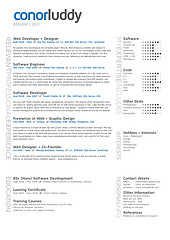
Most people looking for work are sure of the fact that if they could just get to the interview, they could blow potential employers away with their personality and character; demonstrating why they would be a precious commodity to the business.
However, arriving at that stage requires careful orchestration of a resume that will express who you are and what you are about before you even say a word. It can be hard these days as work opportunities are competitive and often hard to come by. So how do you make your resume speak about you as a person and not just an applicant?
The Institute of Recruiters cites their profession as being in the same vein as human resources, confirming the suggestion that job-hunting can be a selective process based on the temperament and disposition of each individual applicant – therefore individuality counts, and should be incorporated.
Resume formatting can be a daunting task at first with so many styles and fonts to choose from. You want your resume to be eye-catching but not improper professional and yet exciting. This, teamed with the inclusion of all information that could be useful without making it too long, can seem like an impossible task, but resume formatting is simple when you break it down.
Font and Style
Perhaps the easiest way to get your resume noticed above the others is by using a striking font. If you are looking for jobs in a creative or artistic arena, perhaps pick something slightly more flamboyant for your titles or headings. This can demonstrate your creative nature and give employers an idea of the effort you are using to show them your personality. If you are searching for jobs in a more commercial arena, choose something bold and straightforward for your font which will indicate your no-nonsense attitude to getting your information across to recruiters. Do not get carried away and include bright colours or clip-art pictures as this can connote a childishness which is never attractive to an employer.
Length and Content
The general rule for resumes is that they should be no longer than one side of A4. This can create pressure on an applicant to make sure they include every aspect of their working character on one piece of paper. This is not strictly true; while you do, of course, need to include the most important information, you can be selective as to what you choose. Remember that you need to get the attention of the employer with a few key facts about your working life, so that when you reach the interview stage you can update them on the other smaller facts that did not make it on to your resume. You must read your resume back to yourself objectively and be as cutthroat as possible when trimming the fat. Try using friends and family as proofreaders; ask them what they think is necessary as you can grow attached to your own resume.
Check and Re-Check
Resume formatting allows you to demonstrate the kind of person you are through how you write about yourself and your achievements. A good test of how resume formatting works is to take your name off your resume and show a copy to a friend or family member. Ask them what they think the person who wrote it is like; does it come across as you intended and are there any aspects of the resume that express your personality negatively? Do not get attached to all the information that you include as you will need to change and edit your resume often and you may need to cut out certain facts that may have become obsolete, for instance certain outdated educational qualifications and unimportant information about your social life.
The substance of a resume is only seconded by the style in which it is presented. There will be hundreds of equally impressive applications out there but if yours can catch an employer’s eye, you are sure to get one step closer to that all-important interview, which will really be your moment to shine.
Photo Credit: ConorLuddy via Compfight cc








